Authentic German Maultaschen
This post may contain affiliate links. See my disclosure policy.
An Authentic Homemade Maultaschen recipe just the way you know and love them from Germany! Save time by making and freezing the meat filling in advance, following our tips about the pasta dough, and make a double batch while you’re at it and freeze the Maultaschen so you can grab, thaw and cook them whenever the craving comes calling!
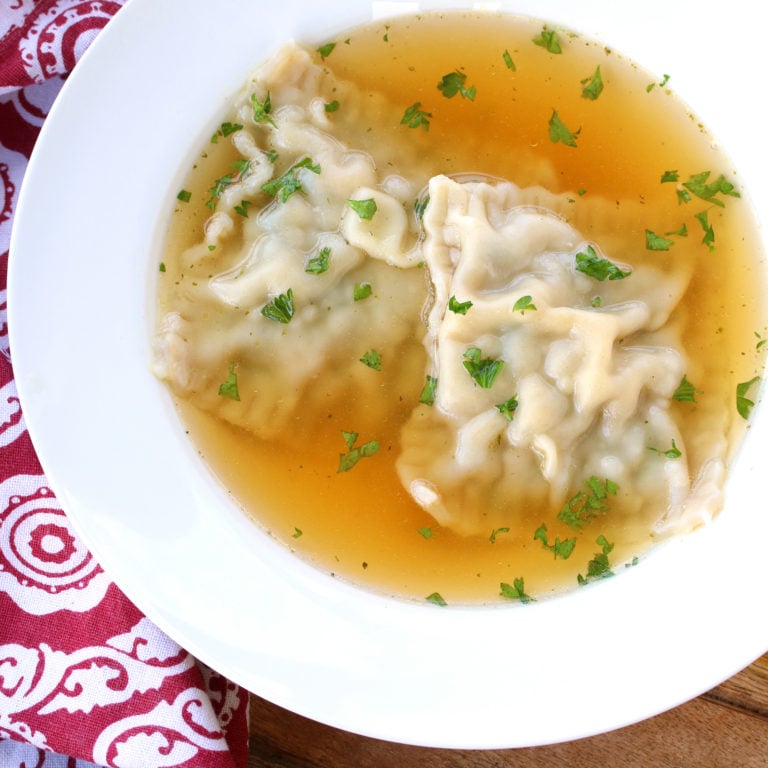
Homemade Maultaschen
As any Swabian will tell you, the Swabia region has the best cuisine in all of Germany. It’s true. And just one of many examples is Maultaschen…those wonderful pasta pockets filled with deliciously spiced meat, bread, onions and spinach. They’re Germany’s version of raviolis and they’re absolute heaven!
Maultaschen has always been one of my favorite German dishes and it’s something I frequently ordered when my family went out to eat in restaurants throughout southern Germany. Being from Stuttgart it was almost guaranteed that I would find them on every German restaurant’s menu. Now that I’ve moved to the U.S. it’s virtually impossible to find them. And if you do find them chances are they don’t taste like the real thing. And that’s why I make my own. These authentic homemade Maultaschen are the real deal. They taste just like the Maultaschen you know and love from Germany!
Where Did Maultaschen Originate?
Maultaschen have a long history and were traditionally associated with Lent, during which Catholics were to refrain from eating meat. The purpose in creating these pasta pockets was to sneak the meat inside of them thereby concealing it from the eyes of God. In this way the carnivorous Catholics could have their meat fix without calling down the lightning from heaven. In fact, there’s a Swabian nickname for Maultaschen, Herrgottsbescheißerle, which means “small God-cheaters.” And there you have it.
It is believed that Maultaschen were first created in the 17th century by the unruly Cistercian monks of the Maulbronn Abbey in the town of Maulbronn for that very purpose. The abbey is not far from where I grew up in Stuttgart. I’ve been there and I have to report that I found no trace of Maultaschen on its premises. But to be fair 500 years has a way of covering up such perishable evidence. So I’m happy to accept the tradition and give the monks full credit for this delicious dish that has since received official EU recognition as a regionally-protected speciality.
There are a few meanings attributable to the name Maultaschen (ie, maul means “mouth,” taschen means “pockets”) but the term Maul is commonly thought to have derived from the town of Maulbronn (Maultaschen being the shortened version of Maulbronn Taschen) and Taschen translates as “pockets,” describing the filled pasta.
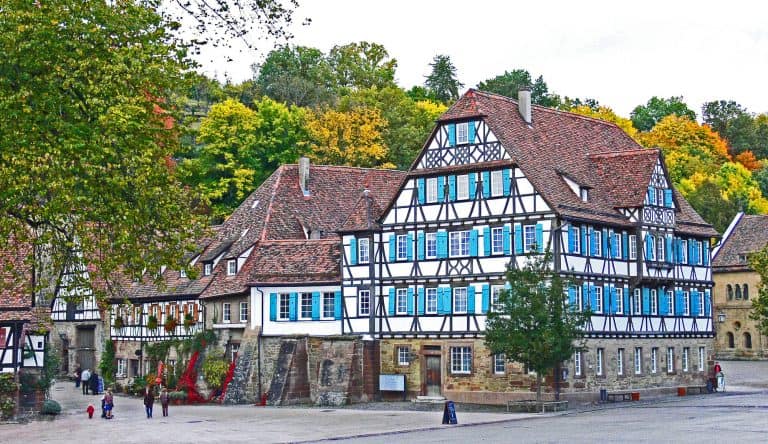

What is Bratwurstbrät?
One of the key ingredients in traditional Maultaschen is what’s called “Bratwurstbrät” in Germany. Without it you simply cannot replicate an authentic flavor.
Authentic German recipes usually call for a combination of ground meat (most commonly ground beef) and something called Bratwurstbrät. It’s the meat mixture that’s used to make German bratwursts (yes, we have a recipe for those too!). In Germany, like bulk Italian or bulk breakfast sausage, you can go to the butcher and get Bratwurstbrät. The challenge is that outside of Germany it’s nearly impossible to find.
And so I’ve developed a recipe for homemade Bratwurstbraet combined with the ground beef to make the Maultaschen filling. And it tastes exactly like the genuine stuff in Germany. Problem solved.
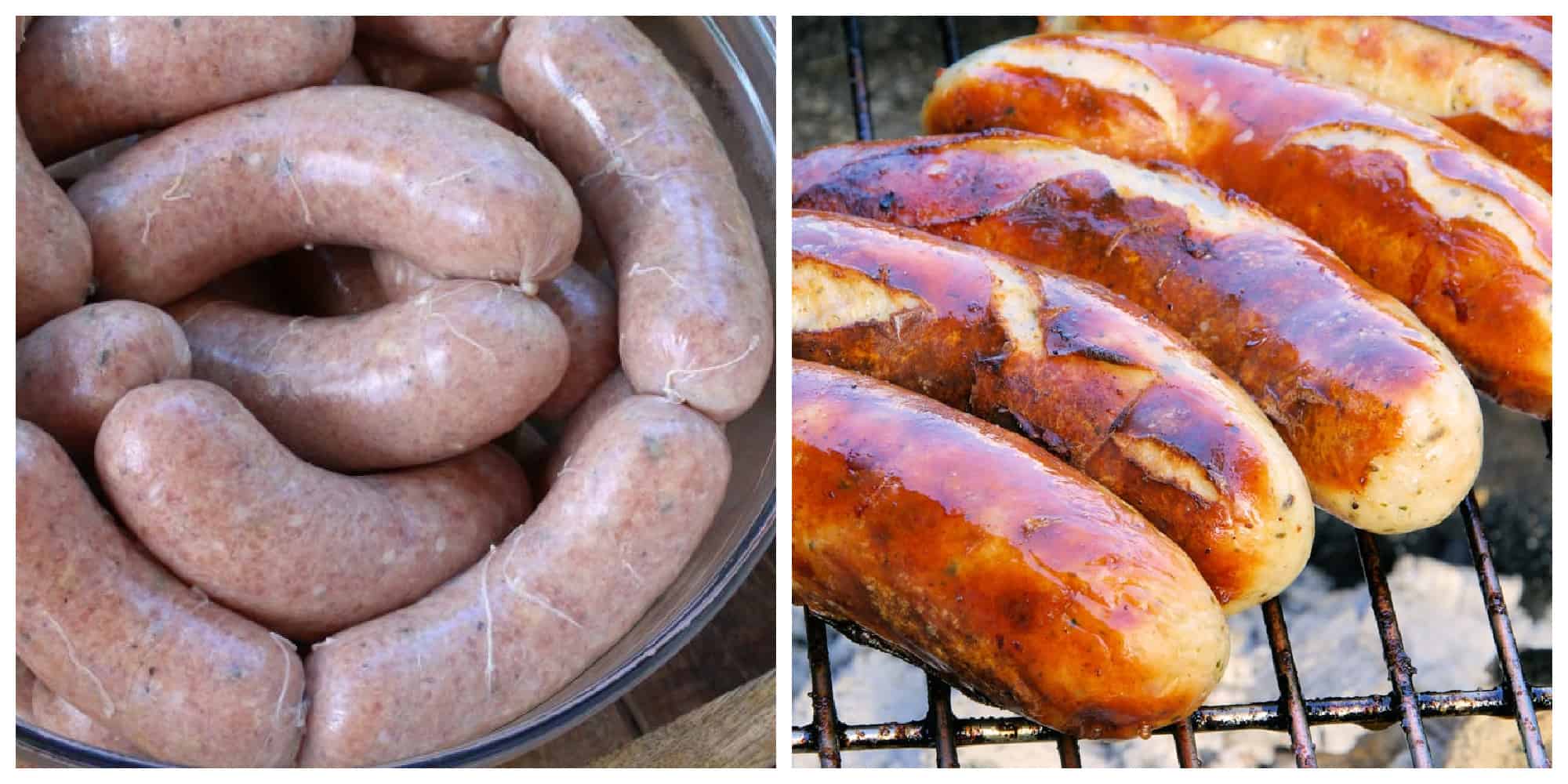
How To Make Bratwurstbrät
Technically, if you can find authentic German Bratwursts you could cut them and squeeze the filling out of them and use that for the Maultaschen filling (in place of the ground pork) along with ground beef. But all of the Bratwursts I’ve found here in the U.S. either taste nothing like authentic German Bratwursts or, in the case of imported ones that I’ve seen, they are pre-cooked so the filling can’t be used.
I’ve developed a recipe for homemade Bratwurstbraet that is combined with the ground beef to make the Maultaschen filling and it tastes exactly like the stuff you’ll find in Germany. Fry a little up and taste it and you’ll recognize the flavor as tasting just like authentic German Bratwursts. This is the filling I use to make my own German Bratwursts with the addition of a few other ingredients needed for the Bratwursts specifically. My Maultaschen filling will enable you to create those authentic-tasting Maultaschen that you know and love from Germany!

Make Sure the Meat Is Properly Mixed/”Emulsified” for the Right Texture
If you don’t have a stand mixer then don’t worry about this. But if you do and you’re determined to get the right texture, the key is making sure you adequately mix the meat until it is what’s called “emulsified”. Meaning if you take a clump of meat and pull it apart with your fingers you should see tiny threads pulling apart. This is the texture needed for making sausages and is what results in a smooth texture. Otherwise you’ll end up with a filling that is more crumbly in texture.
Is There a Shortcut?
Yes, you can use pre-ground meat from the store/butcher, half ground beef and half ground pork. You won’t have any control over the muscle-to-fat ratio so the texture won’t be as smooth but once you add the spices to it it should at least taste the same. Depending on the fat content of the ground meat (if the fat content is too low) it may not emulsify properly when you mix it in the stand mixer. But again, if you’re not too concerned about achieving the perfect texture and are more concerned just about achieving the perfect flavor, you don’t need to worry about that. The perfect texture aspect can be left to German food diehard types like me ;)
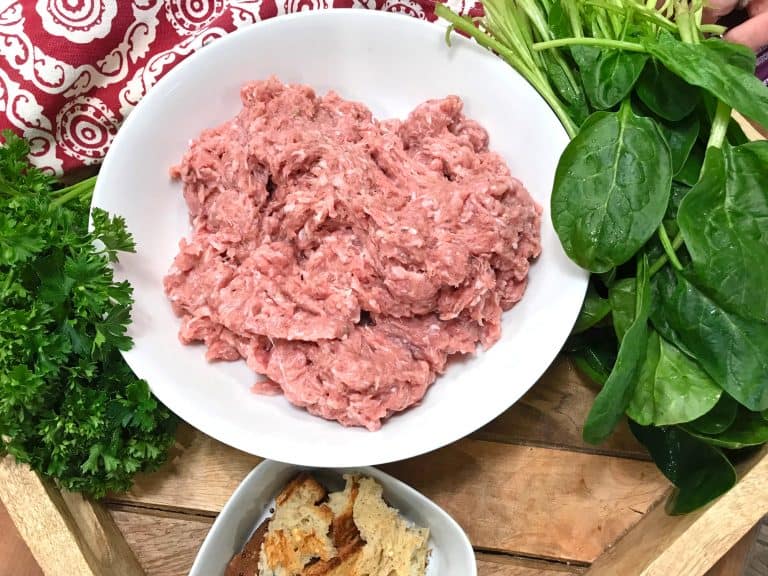
Maultaschen Recipe
Let’s get started!
If you’re using pre-ground beef and pork from the store, skip this step.
If you’re grinding your own meat, pork shoulder is an ideal cut because it has a good ratio of fat to muscle. Also when choosing a cut of beef (I get whatever’s on sale) don’t be afraid if it’s a fatty cut. That fat will help bind the meat when you mix it to create the ideal texture.

To make the Maultaschen filling, place the ground pork and beef, spices and milk powder in the bowl stand mixer fitted with a paddle attachment. Add about 1/2 cup crushed ice to the ground meat mixture in the stand mixture. This will keep the meat cold and prevent the fat from melting as the mixture is mixed/emulsified to create the desired texture.
Mix the meat on low-medium speed for a few minutes (be careful not to over-mix) until the mixture is emulsified. Meaning if you take a clump of meat and pull it apart with your fingers you should see tiny threads pulling apart.
Note: If you’re using pre-ground store-bought beef and pork it may not emulsify properly because of a lower fat content, in which case don’t worry about it and just move on to the next step.
Note: You can use the meat mixture immediately or you can freeze it so you can have it on hand for convenience to save time when you’re ready to make another batch of Maultaschen.
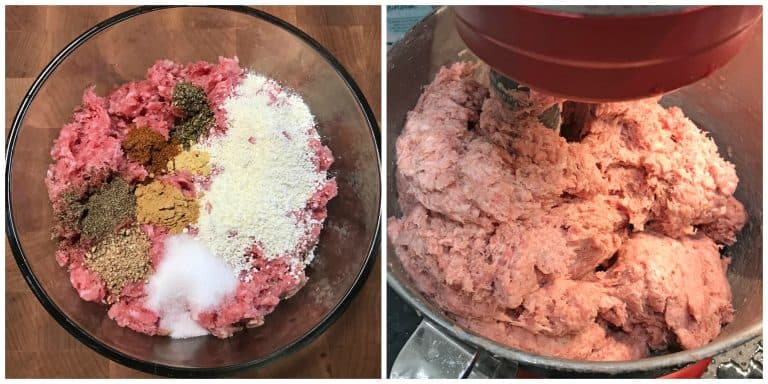
Now let’s prepare the other ingredients for the Maultaschen filling:
Boil the spinach for 1-2 minutes. Drain and rinse under cold water, thoroughly squeeze out the water and very finally chop it.
In a frying pan, heat the butter and saute the onion until soft and translucent, 5-7 minutes. Add the garlic and parsley and cook for another minute or two. Let the mixture cool down so it’s not super hot.
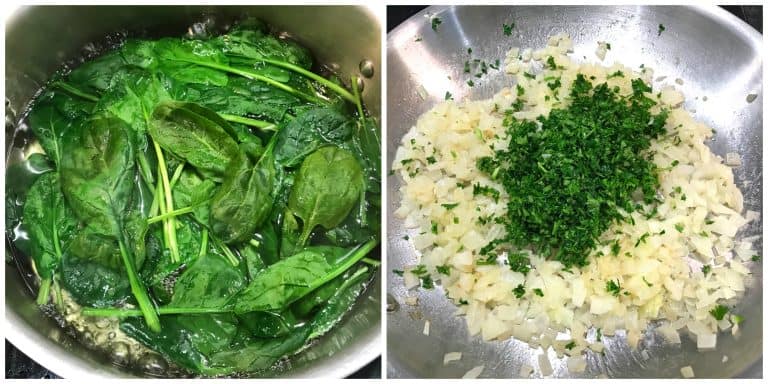
Put the meat mixture in a large bowl along with the onion/parsley mixture, the chopped spinach, prepared breadcrumbs, spices and eggs. Use a stand mixer or your hands to thoroughly combine the mixture.
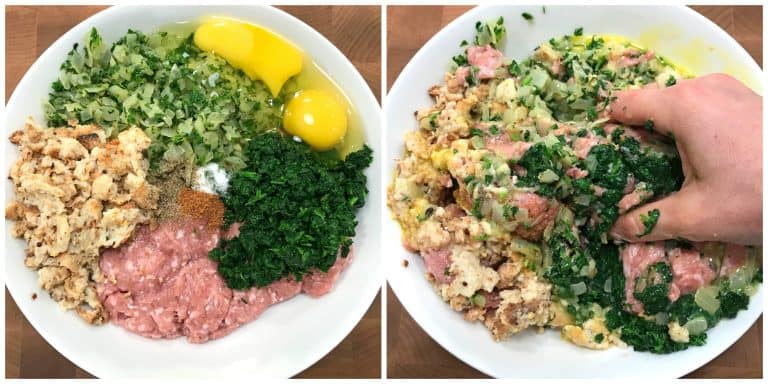
*NOTE: If you prefer an even finer texture you can run about one third or so of this mixture through the blender and then stir it back in to the rest of the mixture.
For the dough you can either use prepared sheets of pasta dough or you can use a shortcut: Wonton wrappers! Wonton wrappers are just basic pasta dough (flour, eggs, water) and they’re already pre-cut into just the right sized squares which makes them super convenient. And unless you have your own pasta machine and make your own sheets of pasta dough, wonton wrappers are WAY cheaper than store-bought fresh pasta sheets. My verdict: Wontons wrappers = Convenient, Easy, Cheaper & Taste the Same. Win-win!
I tend to be a traditionalist when it comes to preparing authentic dishes but if there are modern shortcuts that save time and effort and achieve the same results then I’m all for them!
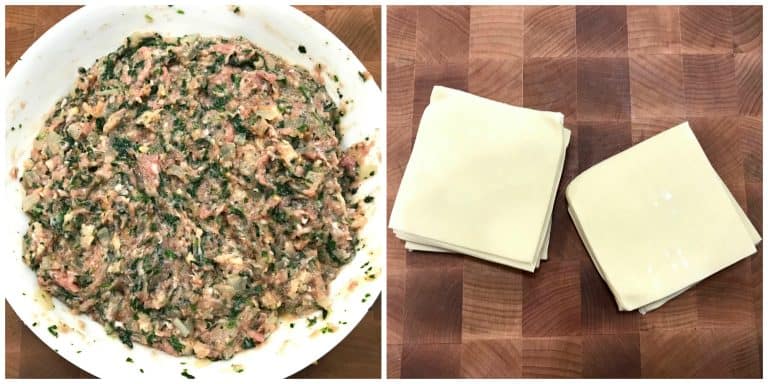
Place a small spoonful of Maultaschen filling on a square of pasta dough (about 3 1/2 x 3 1/2) leaving about 1/4 inch of space from the edges. Brush the edges with the egg, place another pasta square on top and press down with your fingers to seal.
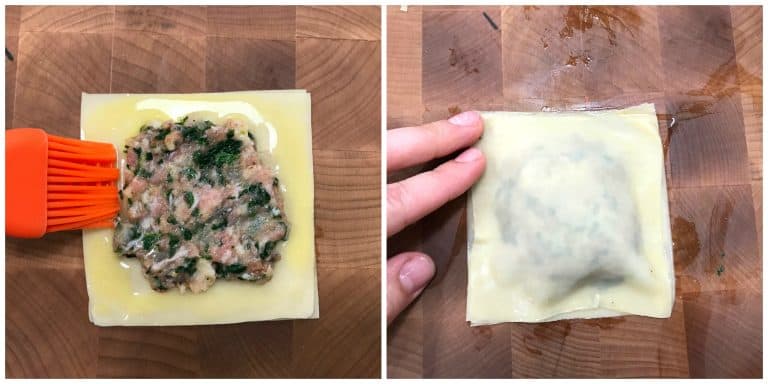
To ensure the edges are sealed tightly you can either use a fork to press the edges together or use a fluted pastry/pasta cutter wheel to make pretty edges.
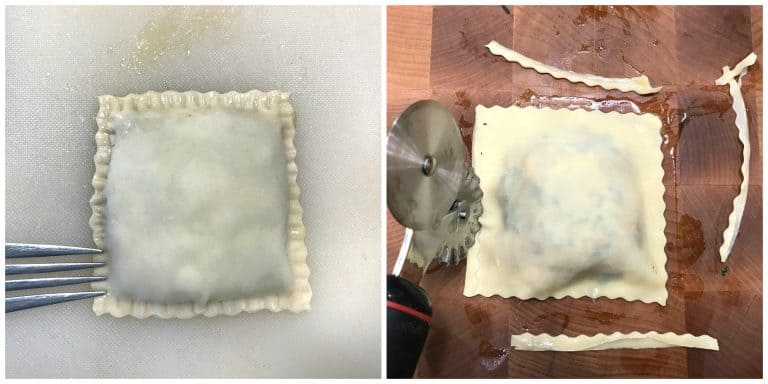
How to Freeze Maultaschen: For convenience you can freeze the Maultaschen at this point. Lay them out in a single layer on a lined cookie sheet and freeze them. Once frozen remove them and put them in an airtight container or ziplock bag and freeze for up to 3 months.
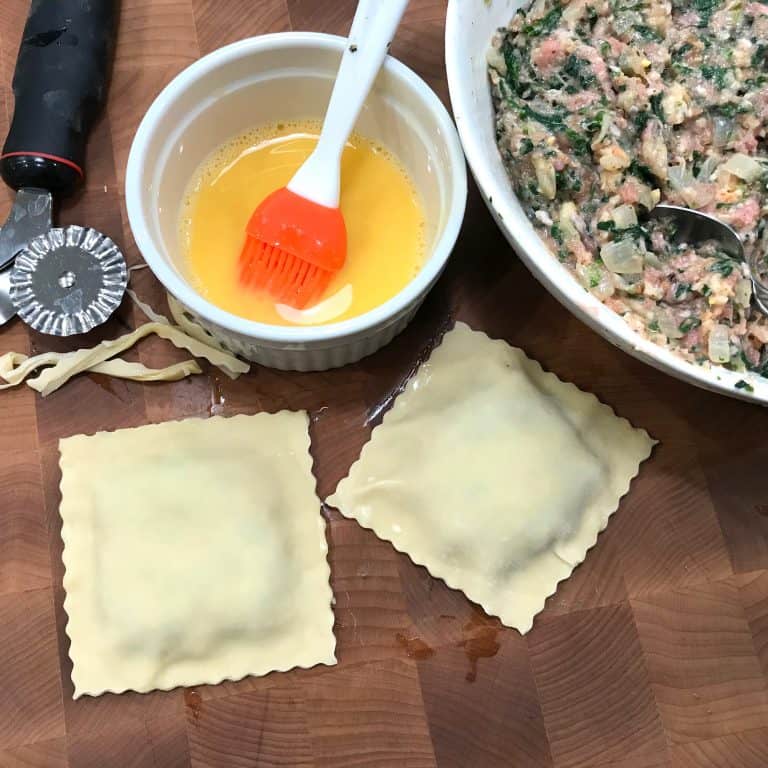
Now it’s time to cook the Maultaschen. Bring a large pot of lightly salted water to a low boil. Working in batches so as to not overcrowd, place the Maultaschen in the pot and keep the water at a very gentle simmer. Simmer for 10-15 minutes.
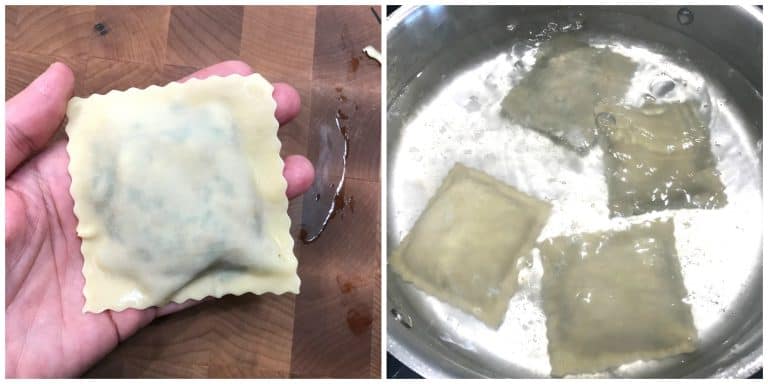
Remove the Maultaschen with a slotted spoon and transfer them to a colander to drain. Store them in an airtight container in the fridge until ready to use. They’ll keep for up to 3 days.
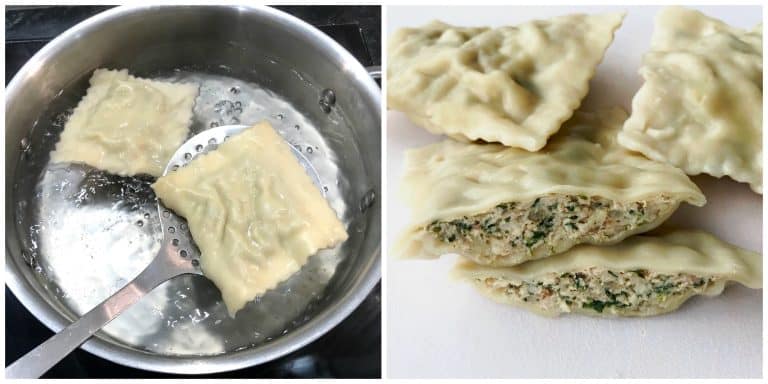
Can You Freeze Maultaschen?
Yes, Maultaschen can be frozen before they’re cooked. Make a double or triple batch while you’re at it so you can have Maultaschen on hand whenever the craving comes calling! After you fill the pasta and seal the Maultaschen shut, lay them out in a single layer on a lined cookie sheet and freeze them. Once frozen remove them and put them in an airtight container or ziplock bag and freeze for up to 3 months.
How To Serve Maultaschen
The ways are limited only by your imagination! The four most popular ways you’ll find them served in German restaurants are:
- Maultaschen in der Brühe: Served in broth (usually beef broth) and eaten as a soup.
- Geschmälzte Maultaschen: Fried in butter and served topped with caramelized onions)
- Gebratene Maultaschen mit Ei: The Maultaschen are sliced and fried in butter with beaten egg and herbs.
- Maultaschen Schweizer Art (Swiss style): Whole Maultaschen are baked with ham and Swiss cheese on top.
All four of these ways are popular and absolutely delicious. I encourage you to try them all!
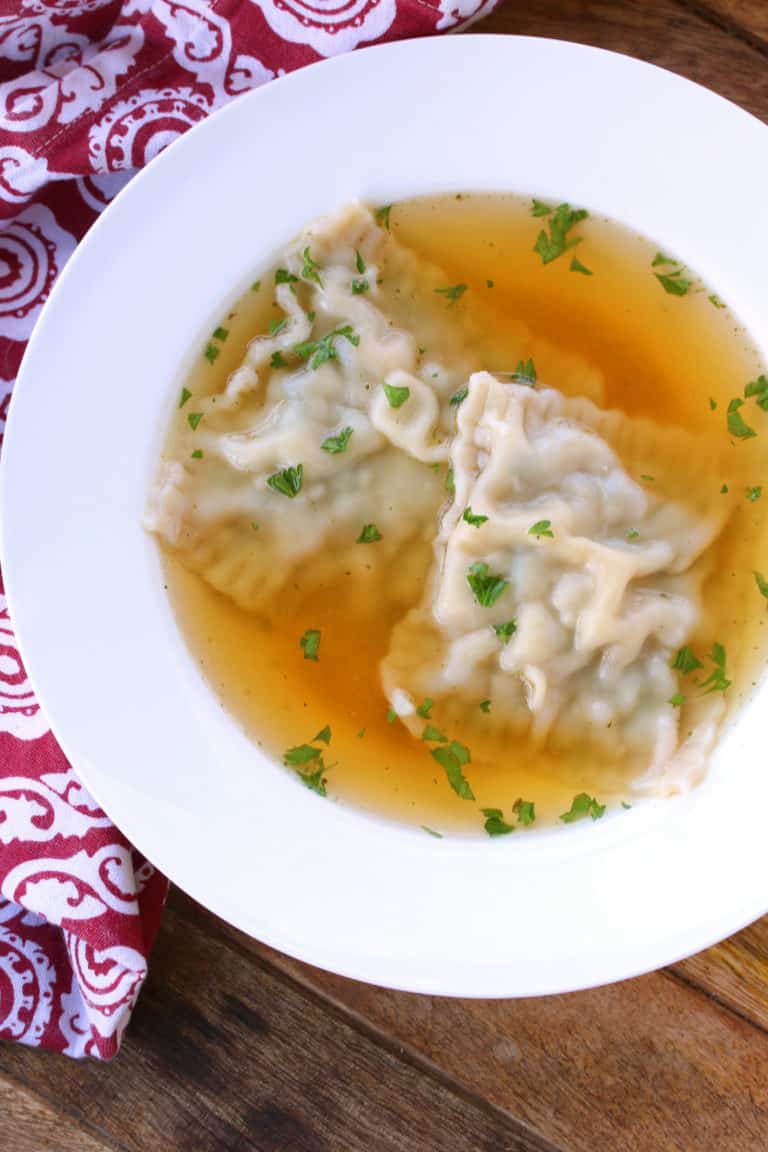
For more Authentic German Recipes to try my:
- Spätzle
- Käsespätzle
- Schnitzel
- Jägerschnitzel
- Sauerbraten
- Rouladen
- Schweinshaxe
- Königsberger Klopse
- German Potato Soup
- German Sauerkraut Soup
- German Potato Salad
- Currywurst
- Semmelknödel
- German Potato Dumplings
- Kartoffelpuffer
- German Plum Cake
- Vollkornbrot
- Rotkohl
- Zwiebelkuchen
Save This Recipe
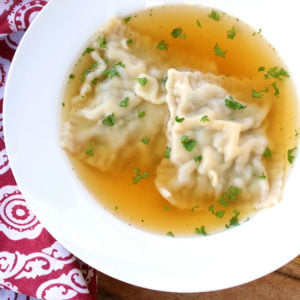
Authentic German Maultaschen
Ingredients
- 1 1/2 pounds fresh pasta sheets , cut into approx 3 1/2 x 3 1/2 inch squares
- OR 52 wonton wrappers , look for ones that contain egg in the ingredients (this is quicker, easier and tastes exactly the same *see blog post for more info)
- 1/2 pound ground pork (see note about grinding your own meat)
- 1/2 pound ground beef (see note about grinding your own meat)
- 1 1/4 teaspoons salt
- 1/2 teaspoon white pepper , freshly ground
- 1/4 teaspoon black pepper , freshly ground
- 1/3 teaspoon ground mace (can substitute nutmeg but strongly recommend mace for traditional German flavor)
- 1/3 teaspoon ground ginger
- 1/3 teaspoon dried marjoram
- 1/4 teaspoon mustard powder
- 1/8 teaspoon ground cardamom
- 1/8 teaspoon ground coriander
- 1 1/2 tablespoons non-fat milk powder (a standard ingredient in sausage-making, it helps bind the meat mixture, helps the cooked meat retain moisture and enhances the flavor. Omit if dairy-free.)
- 1/2 cup finely chopped parsley
- 1 tablespoon butter
- 1 medium yellow onion , very finely chopped
- 1 clove garlic , minced
- 1 bunch (6-8 ounces or 200 grams) spinach
- 2 large eggs
- 1/2 teaspoon salt
- 1/2 teaspoon freshly ground black pepper
- 1/4 teaspoon freshly ground nutmeg
- 8 ounces slightly stale crusty white bread (or fresh croutons) , chopped, placed in a bowl and softened with a few tablespoons of milk (squeeze out excess milk once softened)
Instructions
- **See the blog post for step-by-step photo instructions**
- Place the ground pork and beef, spices and milk powder in the bowl stand mixer fitted with a paddle attachment. Add about 1/2 cup crushed ice to the ground meat mixture in the stand mixture. This will keep the meat cold and prevent the fat from melting as the mixture is mixed/emulsified to create the desired texture.Mix the meat on low-medium speed for a few minutes (be careful not to
over-mix) until the mixture is emulsified. Meaning if you take a clump of
meat and pull it apart with your fingers you should see tiny threads pulling
apart. Set the meat mixture aside until ready to use.Note: If you're using pre-ground store-bought beef and pork it may not
emulsify properly because of a lower fat content, in which case don't worry
about it and just move on to the next step.Freezing the Meat Mixture: You can use the meat mixture immediately or you can freeze it so you can have it on hand for convenience to save time when you're ready to make
another batch of Maultaschen. - Boil the spinach for 1-2 minutes. Drain and rinse under cold water,
thoroughly squeeze out the water and very finally chop it. Set aside. - In a frying pan, heat the butter and saute the onion until soft and
translucent, 5-7 minutes. Add the garlic and parsley and cook for another minute or
two. Let the mixture cool down so it's not super hot. - Put the meat mixture in a large bowl along with the
onion/parsley mixture, the chopped spinach, prepared breadcrumbs, spices and
eggs. Use a stand mixer or your hands to thoroughly combine the mixture.NOTE: If you prefer an even finer texture you can
run about one third or so of this mixture through the blender and then stir it
back in to the rest of the mixture. - For the dough you can either use prepared sheets of pasta dough or you can
use a shortcut: Wonton wrappers. Wonton wrappers are just basic
pasta dough (flour, eggs, water) and they're already pre-cut into just the
right sized squares which makes them super convenient. And they're vastly cheaper than buying pre-made sheets of fresh pasta. Place a small spoonful of Maultaschen filling on a square of
fresh pasta dough (about 3 1/2 x 3 1/2) leaving about 1/4 inch of space from the
edges. Brush the edges with the egg, place another pasta square on top
and press down with your fingers to seal.To ensure the edges are sealed tightly you can either use a
fork to press the edges together or use a fluted pastry/pasta cutter wheel
to make pretty edges.How to Freeze Maultaschen: For convenience you can
freeze the Maultaschen at this point. Lay them out in a single layer on a
lined cookie sheet and freeze them. Once frozen remove them and put them
in an airtight container or ziplock bag and freeze for up to 3 months. - To cook the Maultaschen: Bring a large pot of lightly
salted water to a low boil. Working in batches so as to not overcrowd,
place the Maultaschen in the pot and keep the water at a very gentle
simmer. Simmer for 10-15 minutes.Remove the Maultaschen with a slotted spoon and transfer them to a colander
to drain. - To serve: The most traditional way Maultaschen in der Brühe which is warming the Maultaschen in a rich clear broth (usually beef broth) and serving it as a soup. There are other populars ways to serve Maultaschen (see blog post) and those recipes will follow!
Notes
has a good ratio of fat to muscle. Also when choosing a cut of beef (I
get whatever’s on sale) don’t be afraid if it’s a fatty cut. That fat
will help bind the meat when you mix it to create the ideal texture. Advance Preparation: You can save a lot of time by making the meat mixture in advance (the ground meat and spices) and freezing it until ready to use. You can also freeze the finished Maultaschen before they’re cooked. See note in directions.
Nutrition
Originally published on The Daring Gourmet September 13, 2019



















These are amazing! My Mutti grew up in Germany and she was really impressed with these when I made them for her as a surprise!
Great authentic recipe! We just made them tonight and they taste just like the ones my grandfather made in Germany when I was growing up. So glad I found this recipe and can now create the same delicious taste in the US! Thanks for sharing this great recipe.
I’m so glad you enjoyed it, Carolin, thank you! <3
I was a little hesitant to try this, I am so glad I did . They turned out absolutely delicious!! Thank you for sharing the recipe!!
My great grandma was a Catholic German-speaking child of Swiss German immigrants. She didn’t speak English until she was 7, despite living in Ohio since birth. She always made filled noodles (that’s what she called them), which were served in broth. Now I’m in the mood for these and might have to make them. I haven’t made them in a few years because it’s so much work. We always make fresh pasta but may have to try the wonton wrapper route!
The most likely place to find maultaschen in the United States is among the Pennsylvania Dutch, who call them mauldaschen in their Pennsylfaanisch dialect. Many of the PA Dutch came from Swabia and brought maultaschen with them. Once here they began to modify them using local ingredients such as snapping turtle, buffalo tongue, corn, squash, beans, etc. I have my own recipe for Hickory Nut Mauldaschen using chicken and ham for the meat portion. I make my own dough as well.
These came out great! I used store-bought meatloaf mix (beef/pork/veal). I omitted the milk powder since my daughter has a dairy allergy,but it didn’t seem to matter. I also used won-ton wrappers which were perfect. I might try frozen chopped spinach next time just to save a step. Will definitely make these again!
Fantastic, Janice, thank you for the feedback and I’m so glad you enjoyed them!
May I leave the spinach out without problems? I can no longer eat it
Hi Mary, yes you can omit it entirely or alternatively you can also add any other leafy green of your choice.
My husband lived in Germany for many years with the military. I had never had it but followed your recipe. We all LOVED it! We will be making this regularly. We did it with a beef broth. Amazing! Thank you!
Wonderful, Nicoke, I’m so glad you all enjoyed it, thank you!
This recipe is great. We didn’t have bratwurst so we used ground pork but our maultaschen tasted like the real stuff from Stuttgart. Thank you so much for sharing.
Today we managed to buy some bratwursts from a local German butcher. I’m just wondering if we should skip the spices in the recipe because we have bratwursts or still add them?
Once again thank you so much for sharing!
Wonderful, Natalie, I’m so glad you enjoyed them, thank you! :) Well, it really depends on how good those particular bratwursts are; quality varies so much. I’d say if you like how those brats taste then use them as is, otherwise you can add at least a little of the spices to it, a smaller amount, to bump up the flavor. Thanks again for the feedback!
Thanks for the recipe, I will try it as my mother is Schwäbisch and makes Maultaschen and I’d like to surprise her. Can I freeze the cooked Maultaschen, and if so, how do you suggest I reheat them? Thank you.
Hi Therese, yes they be frozen but I recommend freezing them before they’re cooked as the texture will hold up better for longer. That said you can freeze cooked ones also for up to 2 months. Just let them thaw overnight in the fridge or at room temp and they can be reheated in the microwave.
I’ve spent many, many weeks and months traveling extensively throughout Germany for work over the past 20+ years. Schwabisch Hall was actually where my 1st German destination back in 2001.
Maultaschen in der Brühe was my first German dish. I’ve eaten plenty more of it since that time.
I made this recipe with all the ingredient listed (NO Substitutions) and served it with beef broth garnish with thin sliced green onion. I used egg roll wrappers cut into 1/4ths which is the same size as a wonton wrapper. Not even one broke open when boiling which was my biggest worry.
This recipe is even BETTER than my memories! Very good! Thank you for posting this. 5+++ stars!
I can’t tell you how thrilled I am that you made and enjoyed these, Ray! Thank you so much for the feedback!
Thank thank thank you. It has been so long since I could taste my memories. This recipe does it !
Vielen Dank für ein wunderbares Rezept. Es ist so viele Jahre her, dass ich das gegessen habe; meine Familie kommt aus Baden-Württemberg und ich habe so viele schöne Erinnerungen aus meiner Jugendzeit.
Thank you so much, Tolly, that warms my heart to hear that! <3
One of our favourite meals and the family always enjoys it together. I live in Australia, originally from Backnang about 30km northeast from Stuttgart. I use Leberkaes braet raw from our butcher and if I forget to order it, I have used nueremberger sausages as well.I make my own pasta. In the first few years I have used sausage mince, however that has also mutton in it, so was disappointing, beef/pork mince is ok too. I really prefer the Leberkaes braet. I bake some of it in a loaf tin, and that is another meal with potato salad or fried potatoes. The butcher is from formerly Jugoslavia and they lived for a few years in Stuttgart, so they know Maultaschen. Thank you for posting the German recipe, I enjoy reading them.
Thank you for sharing, Christel, and I’m glad you enjoyed reading this!
I used ground impossible plant meat and the consistency was spot-on. I also left out the ginger, cardamom, majoran, mace and coriander because they are not very german spices. I also didn’t add parsley, milk powder and nutmeg (didn’t have any at home but I would add it next time), and I used mustard instead of mustard seeds.
I made full wheat ravioli pasta dough (No 7 thickness on my Mercato Atlas of pasta maker). It was quite easy, and it was the first time for me to make pasta. Overall a big success. My three year old daughter loves maultaschen and she approves of these so it’s definitely a win. Thanks for the great recipe.
I’m glad you were able to adapt it to your needs, Flo. But not very German spices? Marjoram is a central herb in German cooking and all of the other spices you listed are THE spices that combine to make Lebkuchen and all sorts of very traditional “Gewurz” cakes!
Making this for German night for my cooking club! I think they’ll love it! Any suggestions on how to cook for 7 people and not take 2 hrs to get them all cooked? Boiling a few at a time would take a long time. And am I keeping them warm as I finish a batch? Appreciate any thoughts! Thanks!
Hi Julie, I’d have a couple of pots going at once to speed things up. The Maultaschen can be reheated in a microwave safe dish with a lid on to keep them moist. I hope your cooking club German night is a success!
This tastes like real Maultaschen!!
I don’t care for using the wontons – convenient but not 100% like the real deal to me. But the filling is PERFECT.
Fantastic, Lynn, I’m so glad you enjoyed it, thank you!